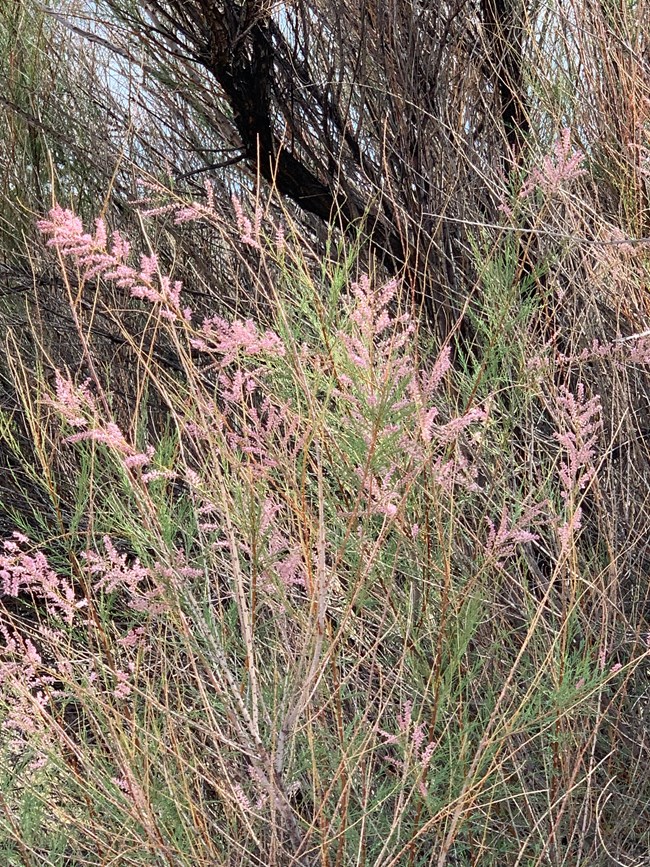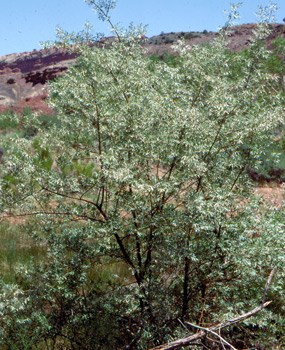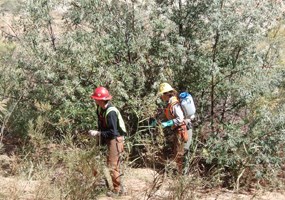What is an invasive or non-native plant?Non-native plants are those that grow outside their native range or typical habitat. Many non-native plants have been introduced as ornamentals or to provide shade, erosion control, and windbreaks. Others have been unintentionally introduced (e.g., in crop seed, ballast water). Non-native plants that spread into natural areas and compete aggressively with native species for water and nutrients are referred to as invasive plants. Invasive plants readily take over an area after a disturbance such as a fire, flood, or grazing. This results in displacement of native species, disruption of food chains, and alterations in nutrient cycles.
There are 126 non-native plant species in Capitol Reef National Park comprising nearly 14% of the park's known vascular plant species. Of the non-native species present, the following twelve are actively controlled because of the threats they pose to native habitats:
The rest are not prone to being invasive and therefore represent a smaller threat, or are too abundant and too difficult to control (e.g., cheatgrass Bromus tectorum, Russian thistle Salsola pestifer, halogeton Halogeton glomeratus). 
NPS Tamarisk (Tamarix chinensis)Tamarisk is a non-native shrub or small tree that has invaded riparian communities in Capitol Reef National Park and throughout the southwestern US. It was introduced to the western US in the 1800s as an ornamental, in windbreaks, and for erosion control. Its native habitat ranges from Spain through northern Africa and Asia. Tamarisk quickly adapted to the southwest and spread along low elevation riverbanks and wash bottoms throughout the region. By the mid-1900s tamarisk was well-established, replacing native riparian vegetation such as cottonwood trees and willows, and significantly reducing the biodiversity and the health of the regions' riparian communities. Tamarisk typically grows 12 to 15 ft tall (3.7 to 4.6 m) and can be identified by its slender grey-green foliage composed of small, fleshy leaves, and its narrow, droopy, clusters of pink flowers at the branch tips. The trunk and branches of mature plants are very dark, while the shoots of seedlings have a reddish color. It has an extensive root system well suited to the hot, arid climates and alkaline soils common in the western US. Tamarisk consumes an excessive amount of scarce desert water and can evaporate or transpire up to 300 gallons per day, significantly more than a similarly-sized cottonwood or willow. The tamarisk leaves that are dropped each year make the soil too salty for most native species to thrive. Tamarisk flowers produce large amounts of seeds and plants can develop into dense thickets, with as many as 3,000 plants per acre that can prevent the establishment of native vegetation. Biological Control of TamariskIn the mid-2000s, the tamarisk leaf beetle (Diorhabda spp.) was introduced from its native China and Kazakhstan into riparian areas of Colorado and Utah in an attempt to use biological control to eradicate tamarisk. Both adult and larval beetles feed on tamarisk until the plant is defoliated. After being repeatedly defoliated, the root system shrinks and the trees typically die within three to four years of beetle infestation. Beetles can't legally be released on federal land, however, they readily move through river corridors and side canyons. Therefore, beetles released east of Capitol Reef have moved into the park. They were first observed in the summer of 2010 along the Fremont River, and in 2011 they were observed in the Hall's Creek drainage in the southern end of the park. Brown, defoliated tamarisk is a good indication that the tamarisk beetles are at work in the area. 
NPS Russian olive (Elaeagnus angustifolia)Russian olive is a non-native thorny shrub or small tree that has invaded riparian areas, old fields, woodland edges, and other disturbed areas in much of the US, including Capitol Reef National Park. Native to Eurasia, Russian olive was introduced to the US in the late 1800s as an ornamental and for windbreaks. Until recently it was recommended as a planting to provide food and cover to wildlife. It can grow to 40 feet (12.2 m) tall and has a silvery-gray appearance due to a dense covering of silvery scales on its stems, buds, and leaves. The branches of Russian olive bear sharp, strong, 2-4 inch (5-10 cm) thorns that can cause injury to people and wildlife, and damage equipment. Flowers are creamy-yellow in color and are very fragrant; they become clusters of hard silvery-green to yellow fruits. Although birds will readily eat the Russian olive fruit, researchers report that bird species diversity is higher in riparian areas that are dominated by native vegetation. As with other invasive plants, Russian olive outcompetes and displaces native vegetation, especially in riparian areas. This can adversely affect wildlife habitat and alter stream flows. In Capitol Reef Russian olive has been especially successful along the Fremont River where it has displaced native cottonwood trees and willows. However, eradication efforts in recent years have noticeably reduced the abundance of Russian olives in the park. 
NPS Control of Invasive PlantsIn an attempt to restore native ecosystems, efforts to eradicate invasive plants have been ongoing for decades, including in many national park sites. Eradication techniques include manual removal (e.g., pulling by hand), mechanical removal (e.g., bulldozing), controlled burns, chemical control using herbicides, or biological control. For tamarisk and Russian olives the most effective methods, and the ones typically used in Capitol Reef, are to cut the plants close to the ground, and then carefully treat each stump with an herbicide or alternatively to carefully apply herbicide directly to the uncut plant stems. In Capitol Reef tamarisk and Russian olive control using these methods has been conducted since the mid-1980s, primarily along the Fremont River and Sulphur Creek. This work has been done by park staff and by members of the NPS Lake Mead Invasive Plant Management Team (IPMT). The IPMT typically works in Capitol Reef during the fall, controlling Russian olive and tamarisk to facilitate the re-establishment of native cottonwood trees and willows. Although the use of herbicides can be controversial, they have proven to be the only effective control method for some of our invasive species. A limited number of herbicides and application methods have been carefully selected for use so as not to be harmful to humans, wildlife or native plants. |
Last updated: May 20, 2020
